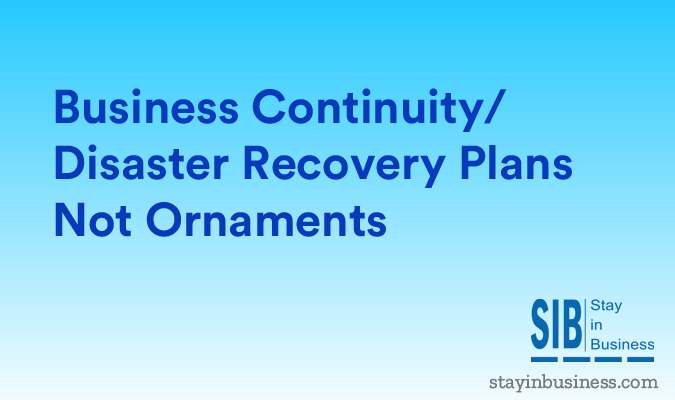Business Continuity/Disaster Recovery Plans are Not Ornaments

Disasters are not only unpredictable, they could be of such a magnitude that the entire infrastructure of the business may be decimated along with loss of life and injuries. Without having a sound Business Continuity and Disaster Recovery plan, a business may not survive the catastrophe. Unfortunately, many a business, takes the “it cannot happen to us” attitude, with devastating consequences.
BC/DR Plan should be considered to be of utmost importance to the businesses long term well-being and survival strategy. It should be considered to be a dynamic, constantly evolving plan, which will ensure business survival.
BC/DR Plan will cost money upfront, without any foreseeable benefits and many businesses are tempted to go in for the easy “one size fits all” plan. Some businesses have a BC/DR Plan which looks good on paper but is actually worthless in practice. Each business has its own compulsions and the BC/DR Plan should be tailor-made to suit each business individually.
A disaster can strike in many ways. Every business can be affected in a myriad of ways such as:
- Computer glitches – both hardware and software
- Damage to buildings
- Damage to machinery
- Floods
- Earthquakes
- Other natural calamities
- Prolonged power outages
- Incapacitation of Key personnel
- Loss of life and injuries to employees
- Employee absence due to families being affected by the disaster
- Other reasons
There may be many other reasons and they may cause even more havoc. Being prepared by building redundancies in the infrastructure and machinery and also taking other mitigating steps is the key to good Business Continuity and Disaster Recovery Planning and Disaster Recovery Planning.
The BC/DR Plan team
One of the first steps in BC/DR Plan is the formation of the core BC/DR Planning team. They should have sufficient expertise in handling crisis situations and should also be armed with the necessary authority to formulate the plans, test and modify it, implement the plan etc. The core team should be carefully chosen, since the team is a primary building block of a sound and effective BC/DR Plan. It is strongly suggested that this team has members from a wide swath of departments and responsibilities.
BC/DR Template
Contrary to the saying ‘One shoe does not fit all’. This makes it a point against getting a standard template, available in the market, as the BC/DR Plan. However, a standard template, would give the basic building blocks for a business, to formulate a BC/DR Plan suited to its unique needs. Each aspect of the standard template should be considered and modified to suit a business organizations needs.
Needless to say, an important aspect of a BC/DR Plan is the need for training, trials and dry runs. The bottlenecks and problems which a trial uncovers, should be studied in detail and solutions found. It should not stop with the solution alone. The solution should be incorporated in the plan and further training and tests carried out. Only when all parameters are met, should the plan be considered final.
Mission critical factors
Some aspects of the business will be more critical than others. All factors that impact production should be listed out in the decreasing order of criticality. When the recovery process is in progress, the more critical functions should be set right first and the process should proceed down the list.
Again, it is worth to note that over time, the critical functions of a business may change in the order of importance. When it increases in criticality, then it should move up the list and the BC/DR Plan should reflect this change. It can be seen that the BC/DR Plan is constantly evolving with time and should be regarded as a dynamic plan.
The Human factor
However detailed a BC/DR Plan is, it remains a ‘paper tiger’, till as such time proper staffing and training makes it a bulwark against a disaster. Every person should know his or her duties as a part of the BC/DR Plan. This is vital because untrained persons, in the face of a disaster, will work at cross purposes. The chances are the severity of a disaster will move from bad to worse due to staff mistakes. Whereas, well trained staff, will not only know what is to be done precisely, they will do it instinctively as a part of their second nature. In case of incapacitation of key personnel, the next in command will seamlessly step into his or her shoes.
A BC/DR Plan is not an ornament; it should be a jewel in the crown of disaster preparedness, hovering in the background, but ready to step forward as a savior of the business.
Categories: Business Continuity, DR Plans
